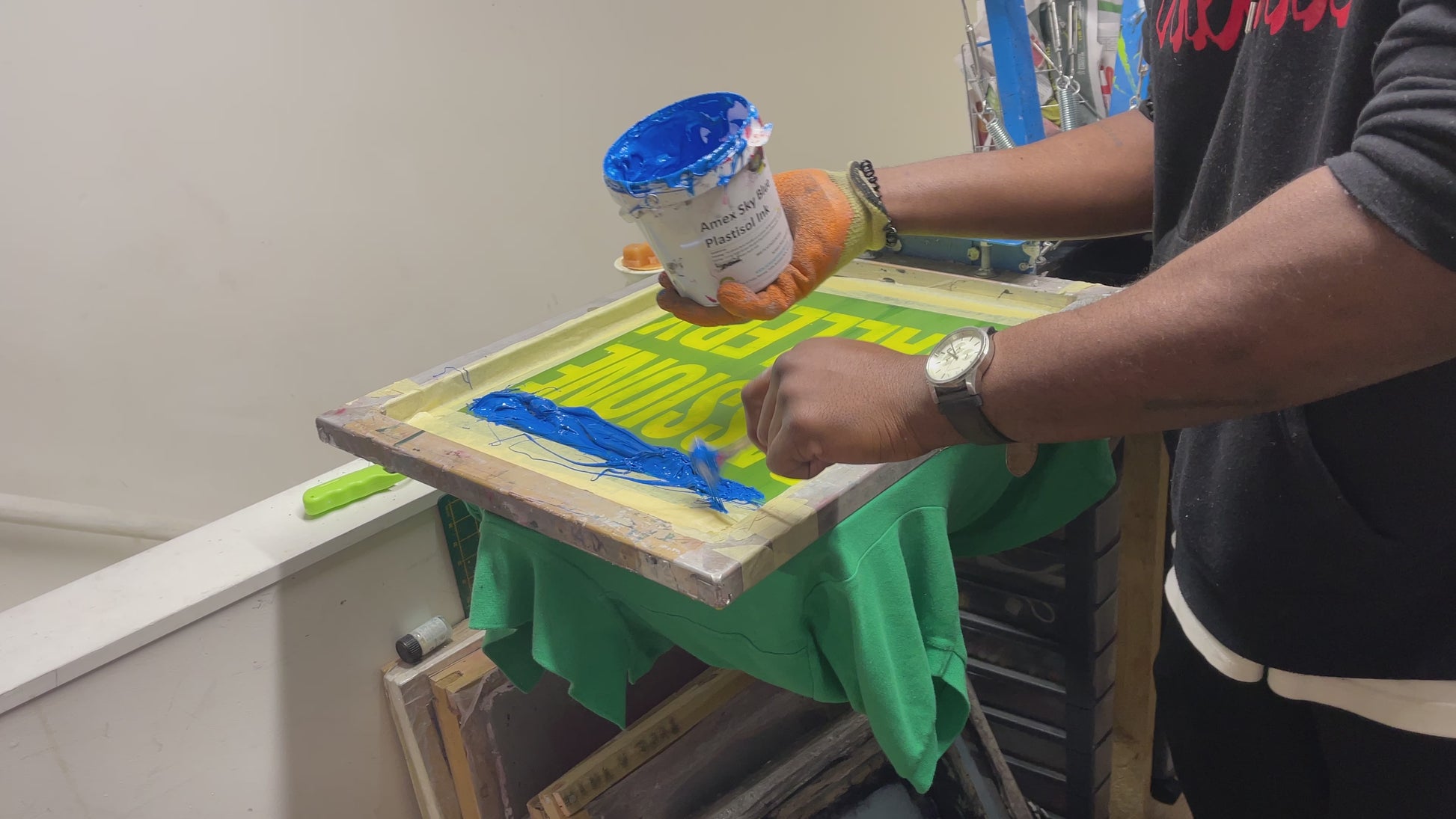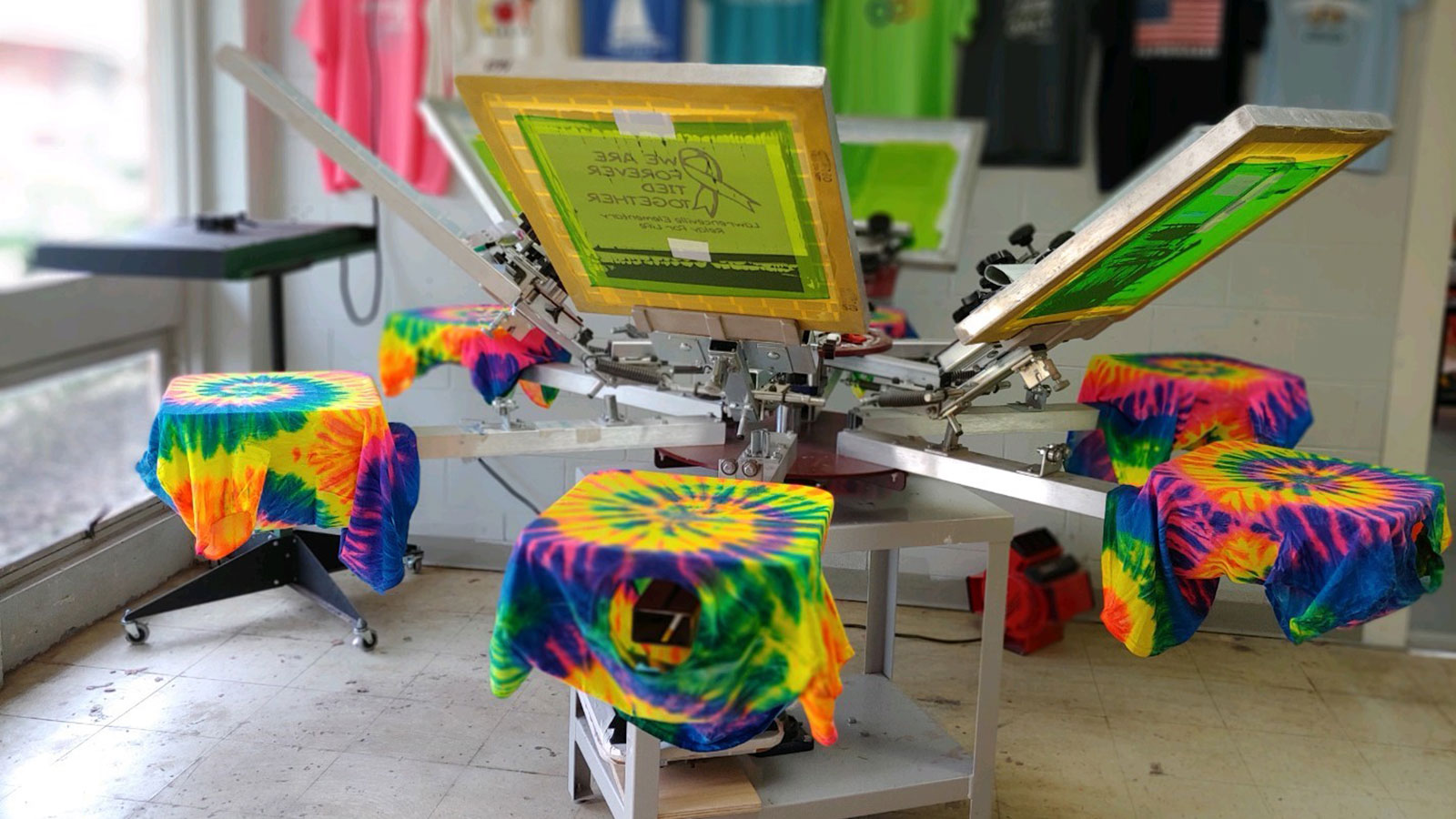Creative T-Shirt Printing Ideas for Small Brands
Creative T-Shirt Printing Ideas for Small Brands
Blog Article
Display Printing Uncovered: Everything You Need to Know Regarding T-Shirt and Garment Printing Methods
Display printing is a fascinating technique that combines art with strategy, providing limitless opportunities for creative thinking. Prepared to discover the crucial elements that make screen publishing an art kind?
The Essentials of Display Printing: Just How It Works
When you dive right into display printing, you'll uncover it's both a science and an art. At its core, screen printing entails developing a stencil, or display, that allows ink to pass via only in certain locations.
Next, you'll mix your inks and prepare your printing surface area. Placement the display over the material, then make use of a squeegee to press ink via the display onto the garment. This procedure requires precision, as you want clear, vivid prints. After printing, you'll heal the ink with warmth, ensuring it sticks to the material and lasts via laundries. Each action is important, and understanding them will raise your screen printing abilities, changing simple garments right into unique, meaningful pieces.
Kinds of Display Printing Strategies
Once you realize the basics of display printing, it's time to discover the numerous strategies that can elevate your layouts. One preferred technique is typical display printing, where ink is pressed via a stenciled screen.
If you're going for great information, think about discharge printing. This technique gets rid of dye from the textile, leaving a soft, vintage appearance. Another choice is plastisol printing, known for its longevity and brilliant colors, making it a favored for numerous brand names. Experiment with halftone printing to develop slope results and elaborate designs. Each method has its distinct charm, so don't think twice to try them out to find what suits your design best!
Essential Equipment for Display Printing
To achieve magnificent outcomes in display printing, having the right tools is basic. You'll require a sturdy screen printing framework, which holds the mesh that transfers your design onto the garment. Next, invest in top quality mops; these are necessary for applying ink evenly across the screen.
Picking the Right Inks and Products
When picking inks and materials for screen printing, you need to think about the sort of ink that functions best for your task. Assume concerning material compatibility to assure your styles look last and fantastic long. Additionally, check out eco-friendly ink alternatives to make your printing procedure more lasting.
Kinds Of Screen Inks
Choosing the appropriate screen ink is essential for accomplishing dynamic, sturdy prints that fulfill your task's demands. There are numerous kinds of display inks to check out. Plastisol ink is popular for its versatility and convenience of use, supplying exceptional color opacity on dark textiles. Water-based ink, on the various other hand, supplies a softer feel and is environment-friendly, making it excellent for those aiming to decrease their ecological effect. Release inks eliminate dye from the textile, leading to a soft, classic look but need specific handling. Lastly, specialized inks, such as metal or glow-in-the-dark, can include distinct impacts to your designs. Review your job requirements and select the ink that lines up finest with your desired end result.

Textile Compatibility Factors To Consider
Comprehending textile compatibility is vital for attaining top quality screen prints, specifically since different products respond uniquely to various inks. Always evaluate your inks on example material to guarantee they adhere appropriately and maintain color honesty. In addition, maintain in mind that textile weight and texture can affect the final outcome, so selecting the right ink and material combo is crucial for your job's success.
Eco-Friendly Ink Options
Environmentally friendly inks are coming to be a preferred selection for screen printers who intend to minimize their ecological impact while preserving top quality. When selecting inks, think about water-based inks, which are much less harmful and much easier to clean up compared to traditional solvents. These inks bond well with textiles, providing dynamic results without hazardous chemicals. You may likewise discover eco-solvent inks that utilize less unpredictable organic compounds (VOCs), making them a safer alternative for both your health and the world.
In addition, search for inks made from eco-friendly sources, such as soy or vegetable-based options. By choosing the ideal inks and materials, you'll not just develop magnificent layouts yet likewise contribute to a more lasting printing procedure. Make the switch, and your prints will certainly reflect your commitment to the environment!
Preparing Your Layout for Screen Printing

Submit Layout Needs
To guarantee your style looks sharp and vibrant on material, you'll need to pay close interest to submit layout requirements for display printing. Make sure your layout has a transparent background to prevent undesirable white edges on your prints. Keep color modes in mind; CMYK is common for screen printing, so transform your RGB creates as necessary.
Color Separation Techniques
Color splitting up is an essential step in preparing your design for screen printing, and understanding it can substantially improve your print top quality. You'll require to break your layout into individual colors, as each shade needs a separate screen throughout printing. This accuracy not just guarantees accurate color representation however also streamlines the printing process.
Resolution and Size
Accomplishing the very best lead to screen printing starts with assuring your design has the appropriate resolution and size. Ideally, your art work needs to go to least 300 DPI (dots per inch) for sharp, clear prints. If you use reduced resolution, your last product might look unprofessional and pixelated.
When it pertains to size, consider the measurements of your print area. Design your art work to match the last print dimension, ideally producing it in the real dimensions you'll be publishing. In this manner, you'll avoid any unanticipated scaling concerns.
Constantly inspect your layout in both vector and raster formats. Vector graphics can be scaled without shedding high quality, making them suitable for screen printing. Preparing properly will guarantee your layout looks incredible on every garment!
Step-by-Step Screen Printing Process
Screen printing is a dynamic procedure that permits you to create vibrant styles on various surfaces. To get going, you'll need a display, emulsion, and your picked ink. First, prepare your display by cleaning it thoroughly. Next off, use screen printing kit the solution evenly and allow it dry in a dark area. As soon as completely dry, reveal your screen to light with your design put on it, which will solidify the emulsion where the light hits, producing a stencil - screen printing kit.
After cleaning out the unexposed solution, your display is ready. Set it up on your printing surface and straighten your garment below it. Put ink onto the display and use a squeegee to push the ink via the pattern onto the textile. Raise the screen very carefully and let the print completely dry. Treat the ink making use of warmth to guarantee durability. That's it! You have actually efficiently screen printed your layout.
Tips for Successful Display Printing Projects
While you're diving right into your screen printing tasks, bear in mind that preparation is essential to success. Begin by gathering all your materials-- inks, garments, squeegees, and screens. A tidy workspace aids stop unwanted errors, so clean before you start.
Next, validate your art work is high-resolution and correctly sized for your garment. Check your display for appropriate exposure and clean it completely to stay clear of smudges. When blending your inks, adhere to the producer's standards to accomplish the best consistency.
During printing, apply even pressure with your squeegee for constant outcomes. Do not hurry; take your time to validate each print satisfies your criteria. After printing, let your garments completely dry totally prior to managing or packaging them.
Finally, always keep an example of your benefit future referral. This means, you can examine your progress and enhance your techniques with time. Pleased printing!

Regularly Asked Questions
For how long Does It Require To Set up a Screen Printing Work?
Establishing a screen printing work commonly takes around 30 minutes to an hour. You'll prepare the screens, mix inks, and adjust journalism. The moment varies based upon complexity and experience, so remain arranged!
Can I Publish on Different Fabric Enters Utilizing the Very Same Strategy?
Yes, you can print on different fabric kinds using the very same technique, yet you'll require to readjust your settings and inks. Some materials take in ink differently, so experimenting warranties the very best outcomes for every product.
What Are Usual Mistakes to Prevent in Screen Printing?
When display printing, avoid common mistakes like utilizing the wrong ink, ignoring correct exposure times, or missing pre-press checks. Always examine your configuration and maintain tidy displays to ensure top quality outcomes each time.
How Can I Properly Clean and Keep My Display Printing Devices?
To properly clean and preserve your display printing tools, you must regularly wash screens with suitable solvents, inspect mops for wear, and guarantee all tools are stored dry and dust-free. Consistency boosts and prevents expensive repairs performance.
Is Display Printing Eco-friendly Contrasted to Various Other Methods?
Display printing can be extra eco friendly than other techniques, specifically if you utilize water-based inks and eco-conscious materials. By choosing lasting materials and methods, you lower waste and lessen your impact on the world.
Screen Printing Uncovered: Everything You Need to Know Regarding T-Shirt and Garment Printing Methods
At its core, screen printing involves creating a pattern, or display, that permits ink to pass through just in certain locations. Position the screen over the fabric, then make use of a squeegee to press ink through the display onto the garment. One preferred technique is standard screen printing, where ink is pressed with a stenciled display.When picking inks and materials for screen printing, you require to take right into account the type of ink that functions ideal for your project.
Report this page